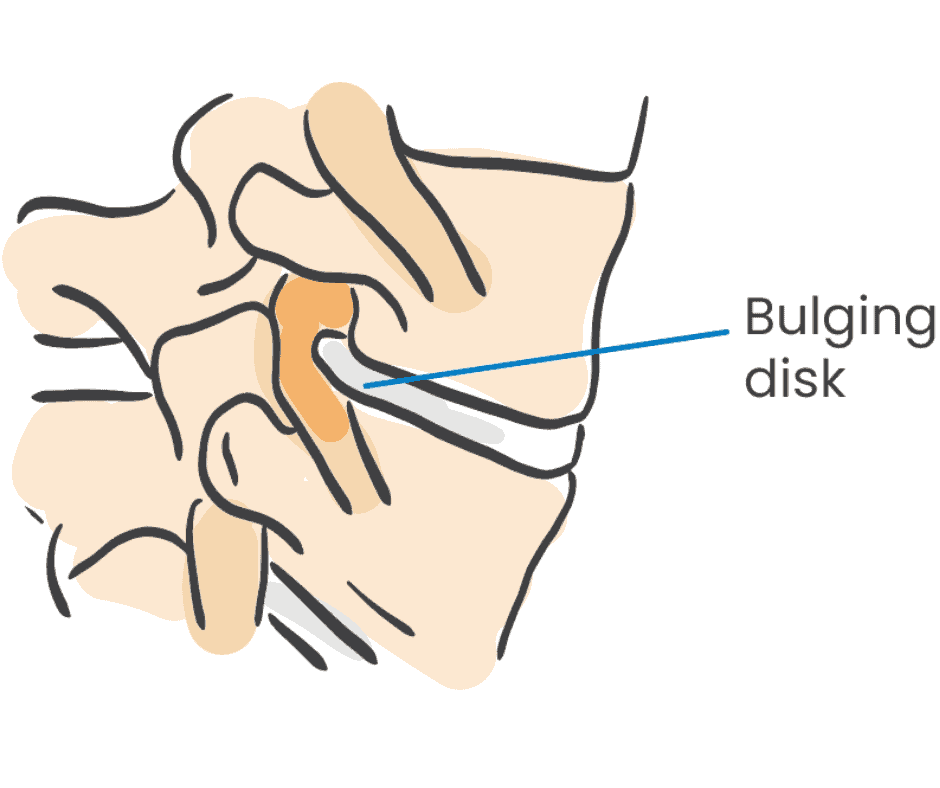What is a Bulging Disc?
- What Are the Risks of a Bulging Disc?
- What Are the Symptoms of a Bulging Disc?
- How is a bulging disc diagnosed?
- What are theTreatment Options for a Bulging Disc?
- Who Should Consider Surgery for a Bulging Disc?
Within the space between the boney portions of your spine (vertebra) is a jelly like disc that acts as a shock absorber. A bulge occurs when the vertebra above and below the disc are compressed and the disc moves outside its normal area.
This can be a normal sign or aging and may or may not cause any problems. A disc bulge does not mean there is a herniation. A herniation occurs when the disc breaks or ruptures. Click here for more information on herniation.

What are the risks of a Bulging Disc?
Risk Factors for Bulging Disc
- Excess weight: causing more stress of joints that are weight-bearing
- Poor posture and ergonomics (study of people’s efficiency in the work environment)
- Trauma – sports related, motor vehicle accidents
What Are the Symptoms of a Bulging Disc?
Symptoms include:
- Some people live with bulging discs and are never aware they have them, they do not cause any problem
- Pain, as the bulge pinches the nerves leaving the spinal canal
- Numbness, tingling or weakness in the arms or legs
- Loss of coordination or difficulty walking
- Loss of bowel or bladder control (seek immediate medical attention)
How is a bulging disc diagnosed?
After an examination and a review of your past medical history your spine surgeon or his physician assistant will order an x-ray and an MRI to determine exactly which level of your spine in affected. After diagnostic testing is completed your physician will determine your treatment plan.
What are the treatment options for a Bulging Disc?
Non-surgical treatment options for bulging disc include physical therapy, exercise, medication, massage therapy, chiropractic therapy, acupuncture, and/or application of heat or cold compresses. Occasionally steroids are injected around the nerves in the spinal column (epidural steroid injections – ESI) easing the pain and reducing the inflammation.
The steroid injections are done by Orlando Orthopaedic Center’s Pain Management Physicians. This is done in an outpatient surgical suite under fluoroscopy (specialized x-ray machine), which allows the steroid medication to be injected around the spinal nerves that are being affected. This may relieve the pain completely. If the pain is not relieved surgery may be indicated.
When non-surgical treatment fails patients might be a candidate for surgery. There are several procedures that can be done depending on the size and location of the bulging disc. Artificial disc replacement, minimally invasive discectomy or if the area is very large causing the vertebra to be unstable after removal of the disc a fusion may be necessary.

Who should consider surgery?
Surgery should be considered for individuals who have failed conservative treatment with medications and injections, or those with symptoms that are so severe that they are starting to lose significant function and are at risk for permanent nerve damage.
All risks and benefits of spine surgery should be considered before making a decision. The spine surgeon will discuss all available options and treatments.


